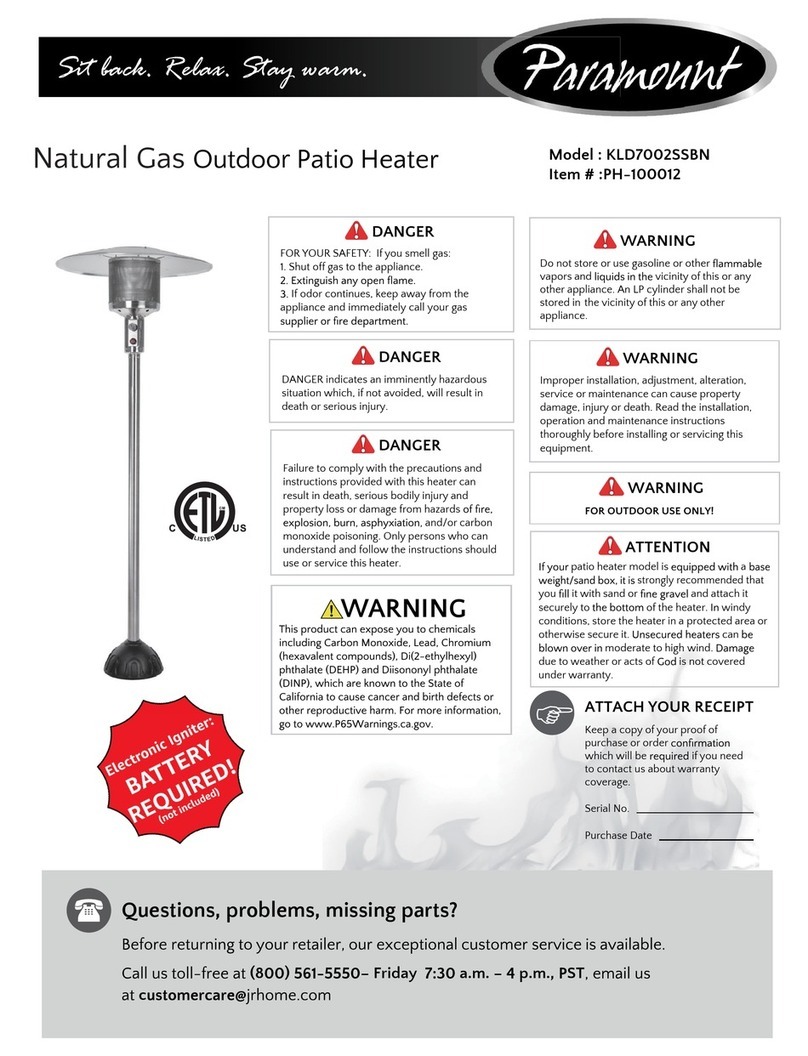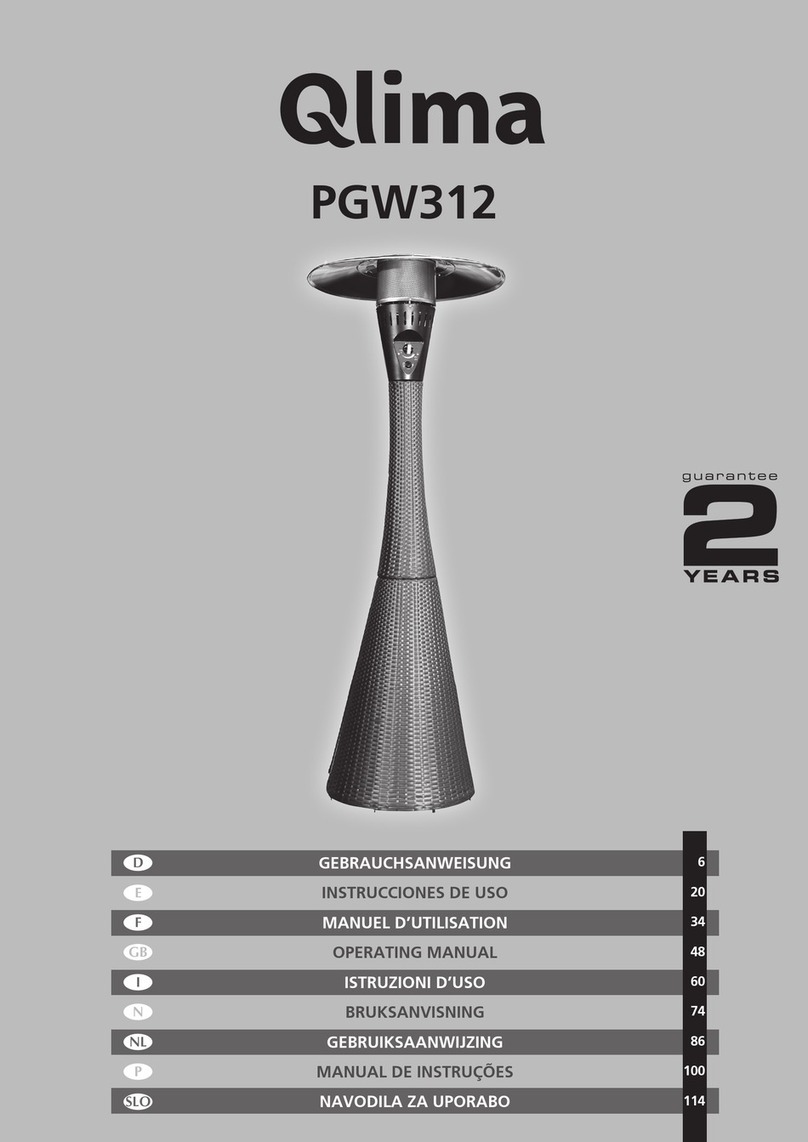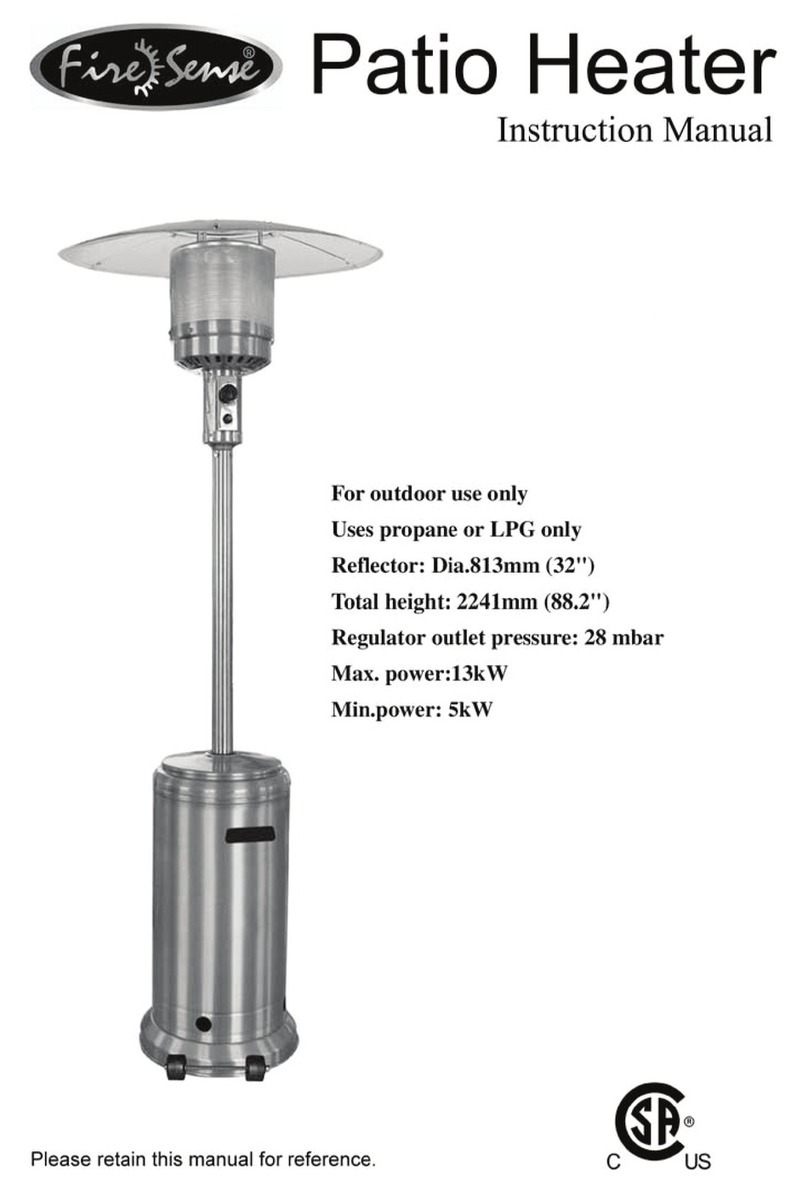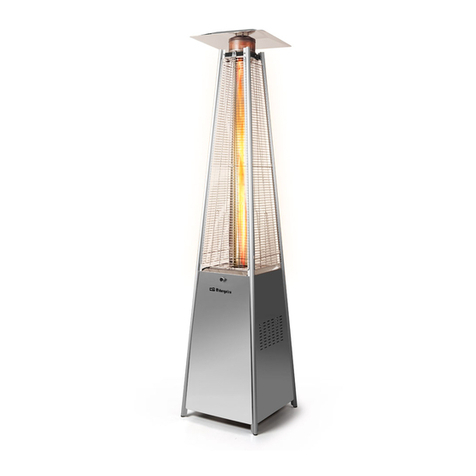Space-Ray COLD BLOCKER WB10CE-N7 User manual

Form 44201360
Oct 2019
INSTALLATION AND OPERATION INSTRUCTIONS
INFRARED RADIANT PATIO HEATER
COLD BLOCKER™
Models:WB10CE-N7 and L7
Two Stage (or Single stage)
UNVENTED - (For all Outdoor applications
and Indoor Non-Residential Spaces)
FOR YOUR SAFETY: If this heater is installed indoors, it must be in a sufficiently ventilated space. Exhaust fans
MUST be operating on an appropriate cycle when heaters are operating to avoid a high concentration of carbon
monoxide. When installed in insufficient ventilated spaces this heater may give off carbon monoxide, an
odorless and poisonous gas. CARBON MONOXIDE POISONING MAY LEAD TO DEATH. Early signs of carbon
monoxide poisoning resemble the flue with headaches, dizziness and nausea. If you experience these signs, GET
FRESH AIR IMMEDIATELY! Have the heaters serviced as soon as possible and check the ventilation into the
building.
!IMPORTANT: SAVE THIS MANUAL FOR FUTURE REFERENCE.
Gas Fired Products (UK) Ltd.
Chapel Lane, Claydon, Ipswich, Suffolk IP6 0JL, England
Phone 01473 830551 Fax 01473 832055 www.spaceray.co.uk email: info@spaceray.co.uk
OWNER /INSTALLER: For your safety this manual must be carefully and thoroughly read and understood before
installing, operating or servicing this heater. This heater is intended for use with either Natural Gas or Propane
Gas. It must be installed by a qualified service person or a licensed contractor in accordance with state and local
codes.
:Improper installation, adjustment, alteration, service, or maintenance can cause property
damage, injury or death. Read the installation, operation and maintenance instructions thoroughly before
installing or servicing this heater. For assistance or additional information, consult a qualified installer, service
agency or the gas supplier.
For Indoor Installations INSPECT all combustion air openings into the building and, if necessary, clear if they
become blocked.
INSTALLER: This manual is the property of the owner. Please present this manual to the owner when you leave
the job site.
IF YOU SMELL GAS:
DANGER
1. Shut off gas to the appliance.
2. Extinguish any open flame.
3. If odor continues, keep away from the
appliance and immediately call your gas
supplier.
DO NOT store or use petrol or other flammable
vapors and liquids in the vicinity of this or any
other appliance.
An LP-cylinder not connected for use shall not
be stored in the vicinity of this or any other
appliance.

Form 44201360 6
Oct 2019
Table of Contents
SAFETY ...................................................................................................................................................................71.0)
INSTALLER RESPONSIBILITY ....................................................................................................................................72.0)
GENERAL INFORMATION........................................................................................................................................73.0)
MINIMUM CLEARANCES TO COMBUSTIBLES ..........................................................................................................94.0)
SPECIFICATIONS ...................................................................................................................................................125.0)
PACKING LIST .......................................................................................................................................................136.0)
HEATER SIZING GUIDELINES .................................................................................................................................137.0)
TYPICAL HEATER LAYOUTS ...................................................................................................................................148.0)
DIMENSIONS ........................................................................................................................................................159.0)
ACCESSORIES........................................................................................................................................................1510.0)
UNPACKING THE HEATER .....................................................................................................................................1611.0)
INSTALLATION......................................................................................................................................................17
12.0)
HEATER MOUNTING ANGLE ............................................................................................................................... 1812.1)
INDOOR INSTALLATION –HANGING METHODS ................................................................................................. 1912.2)
INDOOR / OUTDOOR RIGID HANGING BRACKETS .............................................................................................. 1912.3)
HEAT SHIELD INSTALLATION.................................................................................................................................2213.0)
INSTALLATION OF THE CERAMIC GLASS ...............................................................................................................2514.0)
GAS CONNECTIONS AND REGULATION.................................................................................................................2615.0)
INSTRUCTIONS FOR PRESSURE TEST GAUGE CONNECTION............................................................................. 2815.1)
INLET GAS PRESSURE CHECK............................................................................................................................... 2815.2)
OUTLET GAS PRESSURE CHECK AND ADJUSTMENTS .......................................................................................... 2815.3)
ELECTRICAL CONNECTIONS ..................................................................................................................................2916.0)
INTERNAL CONNECTION WIRING DIAGRAM ...................................................................................................... 3116.1)
FIELD CONNECTIONS AND WIRING DIAGRAMS –2 STAGE................................................................................. 3116.2)
FIELD CONNECTIONS AND WIRING DIAGRAMS –SINGLE STAGE ....................................................................... 3316.3)
VENTILATION .......................................................................................................................................................3417.0)
LIGHTING AND SHUTDOWN INSTRUCTIONS.........................................................................................................3518.0)
SEQUENCE OF OPERATION ................................................................................................................................. 3618.1)
SERVICING AND ANNUAL MAINTENANCE ............................................................................................................3619.0)
TROUBLE SHOOTING ............................................................................................................................................3820.0)
REPLACING PARTS................................................................................................................................................4021.0)
REMOVAL OF GLASS PANEL ................................................................................................................................ 4021.1)
REMOVAL OF SPARK ELECTRODE/FLAME SENSOR ............................................................................................. 4121.2)
REMOVAL OF MAIN BURNER ORIFICE (injector)................................................................................................. 4121.3)
REMOVAL OF GAS VALVE/IGNITION CONTROL MODULE ................................................................................... 4221.4)
DISASSEMBLY OF GAS VALVE/IGNITION CONTROL MODULE ............................................................................. 4321.5)
REMOVAL OF MAIN BURNER/EMITTER ASSEMBLY ............................................................................................ 4321.6)
CONVERSION INSTRUCTIONS ...............................................................................................................................4422.0)
INSTALLATION DATA ............................................................................................................................................4423.0)
REPLACEMENT PARTS GUIDE ...............................................................................................................................4524.0)

Form 44201360 7
Oct 2019
SAFETY1.0)
This heater is a self-contained infrared radiant ceramic heater. Safety information required during installation and
operation of this heater is provided in this manual and the labels on the product. The installation, service and
maintenance of this heater must be performed by a contractor qualified in the installation and service of gas fired
heating equipment.
All personnel in contact with the heater must read and understand all safety information, instructions and labels
before operation. The following symbols will be used in this manual to indicate important safety information.
Warning instructions must be followed to prevent or avoid hazards which
may cause serious injury, property damage or death.
Caution instructions must be followed to prevent incorrect operation or
installation of the heater which may cause minor injury or property
damage.
INSTALLER RESPONSIBILITY2.0)
The installer is responsible for the following:
The heater installation, electrical and gas supplies must be installed in accordance with these installation
instructions and any applicable codes and regulations.
Every heater shall be located with respect to building construction and other equipment so as to permit access
to the heater.
Each installer must follow the clearances to combustible materials for the heaters.
It is important to read and understand section 4.0) where outdoor spaces are defined any space other than
outdoors is an indoor installation.
Install the heater so that the supports and hangers are correctly spaced in accordance with these instructions.
The heater must be supported by materials having a working load limit of at least 52kg.
To install the heater in an adequate free area to allow the products of combustion to freely escape from the
heater. The heater must not be installed in recessed spaces or enclosure and alcoves.
Supply the owner with a copy of these Installation and Operation Instructions.
If the heater is installed indoors, ventilation by gravity or mechanical means shall be provided to supply at least
10m3/h of exhaust air per kW operating heat input.
Never use the heater as a support for a ladder or other access equipment. Do not hang anything from the
heater.
Supply all installation materials necessary that are not included with the heater.
Check the nameplate to make sure that the burner is correct for the gas type in the building.
Use the provided angle gauge (see Section 12.1) to ensure the heater is installed at the approved installation
angles of 0°, 15°, 30°, 45°and 60°degrees with the heat shield installed.
GENERAL INFORMATION3.0)
This heater is a self-contained infrared radiant ceramic patio heater for use in locations where flammable gases or
vapors are not generally present and is intended for space heating non-residential spaces.
This patio heater model is approved indoor and outdoor installation. Not for use in residential dwellings.
Note: A residential dwelling is a domicile intended for use by one or more persons and that includes one or more
areas, such as those used for cooking, eating, living, sleeping, or a sanitary facility. A residential dwelling does not
include a workshop, or outdoors.

Form 44201360 8
Oct 2019
SAFETY REQUIREMENTS
The heater area must be kept clear and free from combustible materials, gasoline and other flammable vapors
and liquids.
This heater is designed for use with one type of gas (G20, G31, etc.). Make sure that the type of gas to be
supplied to this heater matches that shown on the heater rating plate.
DO NOT install this heater directly onto a propane container or propane cylinder. Propane containers or
propane cylinders must not be stored indoors or in the vicinity of any gas-burning appliance.
DO NOT Store flammable materials near the heater.
DO NOT locate gas and electric supply lines directly above the heaters path of flue products. The path of flue
products will change if an optional low clearance heat shield is installed.
Children and adults should be alerted to the hazards of high surface temperatures and should stay away to
avoid burns or clothing ignition.
Young Children should be carefully supervised when they are in the area of the heater.
DO NOT spray aerosols or flammable materials in the vicinity of this appliance while it is in operation.
Clothing or other flammable materials should not be hung from the heater or placed on or near the heater.
NEVER attempt to service the heater while it is plugged in, operating or hot.
Any guard or other protective device removed for servicing a heater must be replaced prior to operating the
heater.
DO NOT Install the heater in a recess, alcove or enclosure.
Installation and repair should be done by a licensed contractor qualified in the installation and service of gas
heating equipment. The heater should be inspected before use and at least annually by a qualified service
person. More frequent cleaning may be required as necessary. It is imperative that the control compartment,
air passageways and burner of the heater be kept clean.
If any changes are made to the patio or building structure after the heaters are installed such as adding plastic
curtains to enclose the patio the modified design must be checked by a qualified person to ensure that the
ventilation requirements are maintained.
DO NOT paint any surface of the heater.
DO NOT throw objects at the heater.
Avoid inhaling fumes emitted from the heater’s first use. Smoke and odor from the burning of oils used in
manufacturing will appear. Both the smoke and odor will dissipate after approximately 30 minutes.
INSTALLATION REQUIREMENTS
Installation of this heater must be in accordance with all applicable codes shown in the instructions and/or the
local codes and authorities having jurisdiction. In the UK all equipment must be installed and maintained in
accordance with the relevant provisions of the Gas Safety (Installations and Use) Regulations 1998 for gas fired
products. Installation practices must take into account the Health and Safety at Works Act 1974 or relevant codes
of practice. In addition the installation must be carried out in accordance with the current IEE wiring regulations BS
7671-latest revision, BS 6896-latest revision (Industrial & Commercial) and any other relevant British Standards
and Codes of Practice by a qualified installer. All external wiring MUST comply with the current IEE wiring
regulations. Heaters shall be installed by a licensed contractor or licensed installer.
Clearances to combustibles as outlined in this manual should always be observed. In areas used for storage of
combustible materials where they may be stacked below the heater, the installer must post signs that will “specify
the maximum permissible stacking height to maintain the required clearances from the heater to combustibles.”
Every heater shall be located with respect to building construction and other equipment so as to permit access to
the heater. Each installer shall use quality installation practices when locating the heater and must give
consideration to clearances to combustible materials, vehicles parked below, lights, overhead doors, storage areas

Form 44201360 9
Oct 2019
with stacked materials, sprinkler heads, gas and electrical lines, and any other possible obstructions or hazards.
Consideration also must be given to service accessibility.
Space-Ray will not recognize the warranty for any use other than space heating.
This heater is for Indoor and Outdoor Installation and is used in Unvented mode. The term Unvented actually means
Indirect Vented. While the products of combustion are expelled into the building, codes require that ventilation by
gravity or mechanical means shall be provided to supply at least 10m3/h of exhaust air per kW operating heat
input to dilute these products of combustion.
This heater is not an explosion proof heater. Where the possibility of exposure to volatile and low flash point
materials exists, it could result in property damage or death. This heater must not be installed in a spray booth
where the heater can operate during the spraying process. Consult your local fire marshal or insurance company.
This heater must be applied and operated under the general concepts of reasonable use and installed using best
building practices.
It is the responsibility of the qualified installer to supply the appropriate lifting equipment to safely install the
radiant heater. Tools required for the safe installation, startup and maintenance are various screwdrivers, wrenches,
pipe wrenches, voltmeter, air and gas manometer, level and required tools to safely install the chosen hanging
materials.
Do not install this heater indoors in a structure with no insulation in the roof—condensation will
occur.
Before installation, check that the local distribution conditions, nature of gas and pressure, and adjustment of the
appliance are compatible.
These instructions refer to appliances designed to operate in the European Union. Appliances designed for other
countries (Non-European Union) are available on request.
This appliance can be used by children aged from 8 years and above and persons with reduced
physical, sensory or mental capabilities or lack of experience and knowledge if they have been
given supervision or instruction concerning use of the appliance in a safe way and understand
the hazards involved. Children shall not play with the appliance. Cleaning and user maintenance
shall not be made by children without supervision.
Children must be supervised not to play with the appliance.
MINIMUM CLEARANCES TO COMBUSTIBLES4.0)
A critical safety factor to consider before installation is the clearances to combustible materials. Clearance to
combustibles is defined as the minimum distance you must have between the surfaces of the heater and the
combustible item. Considerations must also be made for moving objects around the infrared heater.
This heater must not be installed where the products of combustion can build up and prevent
them being exhausted to the atmosphere. This includes applications such as; enclosures, recessed ceilings and
alcoves.

Form 44201360 10
Oct 2019
This heater can be equipped with a heat shield to reduce the clearances to combustibles
towards the ceiling. Due to the variety of possible heater mounting angles the heat shield must be mounted in the
correct location to match the heater mounting angle. See section 13.0 heat shield installation.
Approved installation angles are 0°, 15°, 30°, 45°and 60°degrees with the heat shield installed.
Certain materials or objects, when stored under the heater, will be subjected to radiant heat and
could be seriously damaged. Observe the Minimum Clearances to Combustibles listed in the manual and on the
heater at all times.
For maximum safety the building must be evaluated for hazards before installing the heater system.
Examples include, but are not limited to:
Gas and electrical lines
Combustible and explosive materials
Chemical storage areas
Areas of high chemical fume concentrations
Provisions for accessibility to the heater
Adequate clearances around the openings
Combustion and ventilating air supply
Vehicles parking areas
Vehicles with lifts or cranes
Storage areas with stacked materials
Lights
Sprinkler heads
Overhead doors and tracks
Dirty, contaminated environment
Clearances to combustibles are defined as a surface temperature of 50°C above ambient temperature.
Minimum clearances shall be measured from the outer surfaces of the heater or heat shield if
installed, as shown in the diagrams for the different installation positions.
Fire sprinkler heads must be located at an appropriate distance from the heater. This distance
may exceed the published clearance to combustibles. Certain applications will require the use of high temperature
sprinkler heads or relocation of the heaters.
Sprinkler systems containing propylene glycol or other flammable substances are not to be used in conjunction with
this heater without careful consideration for and avoidance of potential fire or explosion hazards. For further
information consult the authority having jurisdiction. Always observe applicable state and local codes.
The stated clearance to combustibles represents a surface temperature of 50ºC above room
temperature. Building materials with a low heat tolerance (such as plastics, vinyl siding, canvas, tri-ply, etc.) may be
subject to degradation at lower temperatures. It is the installer’s responsibility to assure that adjacent materials are
protected from degradation.
See below the possible surface temperature at the clearance to combustible distance for different ambient
temperatures within the heated space.
Ambient Temperature
20.0°C
17.5°C
15.0°C
Surface Temperature
70.0°C
67.5°C
65.0°C
Clearances to combustibles are posted on the heater. In areas used for storage of combustible
materials where they may be stacked below the heater the installer must post signs that will “specify the maximum
permissible stacking height to maintain the required clearances from the heater to combustibles.” Space-Ray
recommends posting these signs adjacent to the heater thermostat or other suitable location that will provide
enhanced visibility.

Form 44201360 11
Oct 2019
Clearance to combustibles dimensions are shown below.

Form 44201360 12
Oct 2019
SPECIFICATIONS5.0)
MODEL
WB10CE-N7
WB10CE-L7
Heat Input
10.25 kW Hs / 9.23 kW Hi
(minimum 7.0 kW Hs / 6.3 kW Hi)
10.25 kW Hs / 9.23 kW Hi
(minimum 7.0 kW Hs / 6.3 kW Hi)
Appliance Type
A1
A1
Appliance Cat
I2H
I3P
Adjusted for
G20 20mbar
G31 37mbar
Gas supply
60mbar maximum / 20mbar minimum
60mbar maximum / 37mbar minimum
Setting Pressure
15.0 mbar (minimum 7.0 mbar)
26.7 mbar (minimum 12.5 mbar)
Injector (1 piece)
No. 41
No. 51
NOx Class
4
4
Electrical Supply
230V ~ 50Hz 25W
Fuse Externally
3A
Dimensions
L = 1219.2mm W = 300mm H = 243.8mm
Weight
21.8kg
Gas Connection
RP - ½ (BSPT)
Protection
IP23
Model Identification:
Control Option Suffix
Gas Type
Description
N7
G20
Two Stage SIT 843 Gas Valve –High/Low Fire
L7
G31
Two Stage SIT 843 Gas Valve –High/Low Fire
Model No.
Recommended*
Mounting Height
@ 0 º
@ 5 º
to 30 º
@ 30º
to 60 º
WB10CE-N7
2.4 to 3.4m
2.15 to 2.7m
2.15 to 2.44
WB10CE-L7
* For mounting heights outside the recommended distances consult your local Space-Ray Representative.
Ignition System (direct spark):
1.5 second pre-purge period
10 second trial for ignition period
15 second inter-purge period
3 tries for ignition
separate flame sensor
Flame Sensitivity: >0.7μA minimum
Approved installation angles are 0°, 15°, 30°, 45° and 60° degrees with heat shield installed.

Form 44201360 13
Oct 2019
PACKING LIST6.0)
Package contents are listed below:
Model
Part Number
Gas Type
WB10CE-N7
44575000
G20 Natural
WB10CE-L7
44575010
G31 Propane
Number
Part Number
Description
Qty Per
1
See Above
Patio Heater
1
2
41373050
Ceramic Glass 4mm Black
1
3
44568039
Angle Mounting Gauge Plate
1
4
02309000
Eye Bolt 1/4-20x 2"
2
HEATER SIZING GUIDELINES7.0)
Radiant heaters work like the sun to emit radiant heat directly to the space to increase the comfort of the patio
guests. Suitable applications include patios, porches, outdoor shopping areas and pathways.
The amount of temperature increase in outdoor patio spaces will be dependent on the following factors:
1. The number of heaters in the space is important to provide good coverage of the area to be heated.
2. Take care not to mount the heaters too low or too close together this can make people directly below the
heaters uncomfortable.
3. It is recommended to use a suitable windbreak to reduce the effects of direct wind on the patio. If an area is
going to be unprotected and is a breezy location then heaters may need to be located closer together. Wind
breaks must be designed to allow fresh air for ventilation.
4. Angling the heaters greater than 30 degrees should be avoided unless the mounting height is low, when the
heaters are angled more than 30 degrees the radiant intensity is lower and will reduce the amount of heat felt
by the guests.
5. It is recommended to place the heaters in the area of greatest heat loss facing into the patio area.
The table below shows minimum area coverage per heater for outdoor patio heating based on a 2.5 to 5.5°C
temperature rise.
Mounting Angle
Mounting Height
Breezy Exposed
Location
Moderately
Protected
Well
Protected
Horizontal
2.4 –3.4m
2.4 x 2.4m
3.0 x 3.0m
3.7 x 3.7m
Up to 30 Degrees Angled
2.15 –2.7m
2.4 x 2.4m
2.7 x 2.7m
3.3 x 3.3m
30 to 60 Degrees Angled
2.15 –2.4m
Not Recommended
2.4 x 2.4m
Note: When sizing the number of heaters to warm the patio, the area coverage given above may not provide the
stated temperature rise under all weather conditions and will be dependent on heater placement. Minimums are
shown as a guideline for human comfort. For more assistance with patio heater sizing and layout please contact
your local Space-Ray representative.

Form 44201360 14
Oct 2019
TYPICAL HEATER LAYOUTS8.0)
The diagram below shows the recommended spacing layout between heaters.
Dimension
Horizontal
15 to 30 degree angle
Above 30 degree angle
Min.
Max.
Min.
Max.
Min.
Max.
A. Mounting Height
2.4m
3.4m
2.15m
2.7m
2.15m
2.4m
B. Distance to the end of the
patio
0m
1.8m
0m
1.8m
0m
1.8m
C. Distance between heaters.
2.4m
3.7m
2.15m
3.4m
1.8m
3.0m
D. Distance between heaters*
2.4m
4.9m
2.4m
5.5m
2.4m
4.9m
*Note the distance D for angled heaters applies when they are facing towards each other.
Below are examples of patio heating applications.

Form 44201360 15
Oct 2019
DIMENSIONS9.0)
ACCESSORIES
10.0)
Below are the optional accessories available for the Wind Blocker Patio heater.
PN
Description
Picture
44560350
Wall / Ceiling Telescopic Mounting
Bracket Kit- 380-560mm overhead
space (check clearances to
combustibles space above the
heater before ordering)
44560351
Ceiling Telescopic Mounting
Bracket Kit- 560-760mm overhead
space (check clearances to
combustibles space above the
heater before ordering)

Form 44201360 16
Oct 2019
PN
Description
Picture
44560352
Wall / Ceiling Telescopic Mounting
Bracket Kit- 15"-30" overhead
space (check clearances to
combustibles space above the
heater before ordering) includes
both the 380-560mm (15-22”) and
560-760mm (22-30”)
extension legs.
44566300
Heat Shield Kit –Reduced
clearances to combustible option
when installed. Mounting angles
are restricted to 0°, 15°, 30°, 45°
and 60°.
44560599
Column Mounting Arm Kit –
suitable for columns 200mm (8”)
and wider.
44560607
75mm (3 ") Pole Mounting Bracket
Kit
44560608
100mm (4") Pole Mounting
Bracket Kit
UNPACKING THE HEATER11.0)
The heater and ceramic glass are shipped separate but in the same box. Care must be taken
when up-packing the heater. Carefully open the top of the heater as indicated on the labels at the side of the
shipping box. An angle gauge is attached to the heater’s control side with tape and is needed for installation (see
Section 12.1).
The glass is located on top of the heater and is wrapped in cardboard cradled into the foam end pieces. Carefully
remove the top foam pieces and remove the cardboard wrapped glass. Care must be taken that during handling
the glass does not slide out of the cardboard wrap. Store the glass in a secure location for later assembly.

Form 44201360 17
Oct 2019
It is recommended that two people lift the heater out of the carton. Do not remove from the
remaining packaging until the heater is ready to be hung.
INSTALLATION12.0)
In order to protect the ceramic glass it is recommended to only insert the ceramic glass once all the other
installation steps have been completed. The ceramic glass must be removed to wire the heater and for
commissioning.
Various means of suspending the heater can be used.
a) Heaters installed outdoors or in areas subject to strong winds must be installed using the optional hanging
brackets or suitable rigid mount hardware. Chain, cable and other flexible hanging methods are not
recommended.
b) Use only noncombustible materials for suspending hangers and brackets.
c) Turnbuckles can be used with chains to allow leveling of the heater. All “S” hooks and eye bolts must be
manually crimped closed by the installer.
d) Heaters must not be supported by gas or electric supply lines and must be suspended from a permanent
structure with adequate load capacity.
e) Hanging points are a fixed length between centers. Secondary steel work may be required to span between
supporting beams.
f) The appliance should be located with respect to building construction and other equipment to permit
access to the appliance for servicing etc.
f) The heater must be installed in an adequate free area to allow the products of combustion to freely escape
from the heater. The heater must not be installed in recessed spaces or enclosure and alcoves.

Form 44201360 18
Oct 2019
g) The heater must be suspended with its longitudinal axis horizontal, but may have its lateral axis at an angle
from 0° to 60° from the horizontal, as shown in the minimum clearances to combustibles section 4.0).
h) An optional heat shield may be installed to reduce the top distance of clearance to combustibles. This heat
shield should be installed prior to hanging the heater. When using the heat shield at the minimum
clearance distance the angles of installation are restricted to 0°, 15°, 30°, 45° and 60°.
i) Use the provided angle gauge to ensure that the heater is hung at the approved installation angles.
j) The heater can be angle mounted on both sides of its lateral axis.
k) Hanging brackets should first be fixed to the wall surface by means of 4 lag bolts –not supplied (M10 x
75mm minimum) through pre-formed holes in each of the brackets prior to installing heater.
HEATER MOUNTING ANGLE12.1)
Every heater is supplied with an angle gauge. The gauge is attached with tape to the heater control side.
The angle gauge is used in combination with a level to ensure that the heater is installed at one of the mounting
angles of 00, 150, 300, 450and 600.
Hold the side of the angle gauge without label flush against the glass surface. Hold a level against the other side of
the angle gauge and find the desired installation angle of the heater. Verify that the level is vertical, adjust heater
angle if needed. This process must be repeated for both ends of the heater
Note: If a heat shield is installed its location must match the heaters angle (see Section 21.0).

Form 44201360 19
Oct 2019
INDOOR INSTALLATION –HANGING METHODS12.2)
When the heater is used for an Indoor Installation then the following hanging methods may be used.
The heater can be hung from the ceiling, secondary steel work, etc. using chains, threaded rods and other approved
hanging materials. All hanging materials must have a minimum working load of 52kg. Any “S” hooks must be
crimped closed after installation.
Note:
When hanging the heater hanging materials which allow the heater to move the gas connection must be
established using an approved flexible gas hose of a minimum of 600mm length.
Diagram below shows Horizontal mounting with chain.
Diagram below shows the possible chain methods to hang at different angles.
Notes: When suspending at 25 degrees if the heat shield is installed use the 30-degree location for the heat shield.
INDOOR / OUTDOOR RIGID HANGING BRACKETS12.3)
Fixed hanging methods which prevent the heater from swaying must be used for outdoor installations.
Below are the bracket kits which can be used for ceiling and wall mount for patio heaters installed indoors and
outdoors, with and without heat shields. The brackets provide for a range of lengths and approved mounting angles
of 150, 300, 450and 600.
44560350 KIT, BRACKET - WALL/CEILING 380-560mm CEILING - FOR USE WITH HEAT SHIELD (telescoping)
44560351 KIT, BRACKET - CEILING 560-760mm - FOR USE WITHOUT HEAT SHIELD (telescoping)
44560353 KIT, BRACKET - CEILING 10" –FIXED (For Horizontal mounting with a heat shield - non-combustible
ceiling only)

Form 44201360 20
Oct 2019
The hanging brackets are supplied as an optional accessory item. Below are the kit contents.
Item No.
Part No.
Description
44560350
Quantity
44560351
Quantity
44560353
Quantity
1
02140040
HHCS,1/4-20 x 1/2" SS
6
6
4
2
02129100
WASHER, FLAT 1/4"N SS
6
6
4
3
02167019
LOCKNUT, 1/4-20 KEPS - SS
6
6
4
4
44560259
HANGER BRACKET –RECEIVER
2
2
5
44560269
SLIDER ARM –LH
1
6
44560279
SLIDER ARM –RH
1
7
44560289
SLIDER ARM –LH
1
8
44560299
SLIDER ARM –RH
1
9
44560809
FIXED ARM
2
The tables below can be used to select the correct bracket to ensure that the heater is installed at the correct
clearance to combustible distance from a combustible ceiling according to the mounting angle and whether a heat
shield is installed.
Mounting Angle
380-560mm Bracket (With heat shield)
telescope hole positions*
560-760mm Bracket (Without heat
shield) telescope hole positions*
0
1 to 5
3 to 5
15 and 30
2 to 5
3 to 5
45 and 60
4 or 5
4 or 5
* The above table relates to the holes positions as shown in the figure below for the two different length adjustable
brackets.

Form 44201360 21
Oct 2019
12.3.1) HANGING BRACKETS ASSEMBLY
A left-hand LH and right-hand RH bracket must be assembled. Torque screws and locknuts to 6.8Nm.
To mount the hanging brackets to the wall/ceiling:
1. Measure and mark distances for the hanger bracket holes.
2. Hanging brackets should first be fixed to the wall or ceiling surface by means of 4 lag bolts –not supplied
(M10 x 75mm (3/8” x 3”) minimum) through pre-formed holes in each of the brackets prior to installing
heater. All hanging materials must have a minimum working load of 52kg.
12.3.2) HEATER ATTACHMENT TO HANGING BRACKETS
The heater can be attached to the hanging brackets in angles of 150, 300, 450and 600. Choose the desired heater
mounting angle and find the corresponding hole pattern as per the wall and ceiling mount figures below.
Attach the heater to the brackets using (2) cap screws, flat washers and locknuts provided in the kit. Torque screws
and locknuts to 6.8Nm.
Minimum clearances to combustible must be observed. See Section 4).

Form 44201360 22
Oct 2019
HEAT SHIELD INSTALLATION13.0)
A heat shield can be used to reduce the clearance to combustible distances. Refer to Minimum Clearance to
Combustibles in Section 4). The heat shield is available as an accessory Kit No. 44566300.
Item No.
Part No.
Description
Quantity
1
02359000
#10-24 DOME CAP NUT
2
2
02358000
TEFLON WASHER
4
3
02186010
#10-24 SS LOCKNUT NUT
2
4
02352000
PHSMS #8 x 1/2" AB POINT SS - BLK OXIDE
8
5
44568139
RAIL - HEAT SHIELD HANGER - PAINTED
1
6
44566189
HEAT SHIELD - ROLLED/PAINTED
1
7
44568149
HOLDER BRACKET - PAINTED
2
8
43247112
LABEL, INDOOR CLEARANCES (with heat shield)
1

Form 44201360 23
Oct 2019
The heat shield position on the heater is dependent on the heater mounting angle. Use the angle gauge provided
with the heater to determine the mounting angle before proceeding with the heat shield assembly. See Section
12.1
See below for installation steps.
Step 1. Use the angle gauge shown below to determine the mounting angle of the heater.
Step 2. Attach the (2) holder brackets to the top of the heater using (2) black oxide #8 screws per bracket.
Step 3. Identify the correct holes to mount the shield hanger rail from the illustration below.
Step 4. Attach the heat shield hanger rail to the holder bracket using (2) black oxide #8 screws on each end.
Horizontal position shown below.

Form 44201360 24
Oct 2019
IMPORTANT: Use the Dome Cap nuts at the control end of the heater as shown in the
illustrations so that the heat shield can expand when the heater is turned on. Failure to do so may result in the heat
shield distorting.
Step 5. Attach the heat shield to the hanger rail using the holes in the heat shield indicated below for horizontal
mounting.
Step 6. Place the new clearance label on the control end of the heater. NO NOT PLACE LABEL ON THE HEAT SHIELD.
See below the correct holes to mount the heat shield to the hanger rail for other installation angles.
This manual suits for next models
1
Table of contents
Popular Patio Heater manuals by other brands

Outsunny
Outsunny 842-186 Assembly & instruction manual

SunGlo
SunGlo PSA 265 Installation, operation & maintenance manual
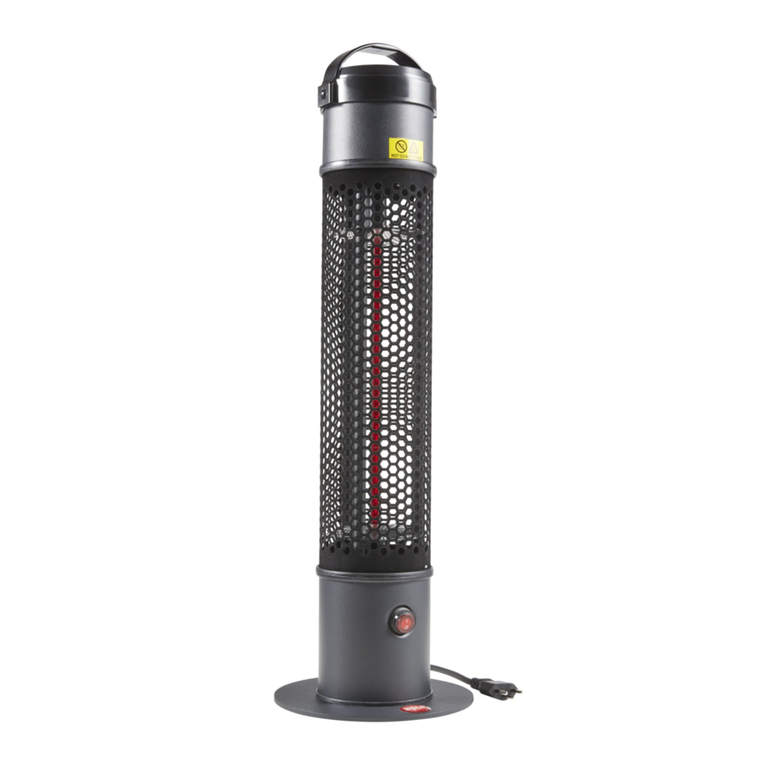
Ayce
Ayce THL 020 MANCORA Original instructions
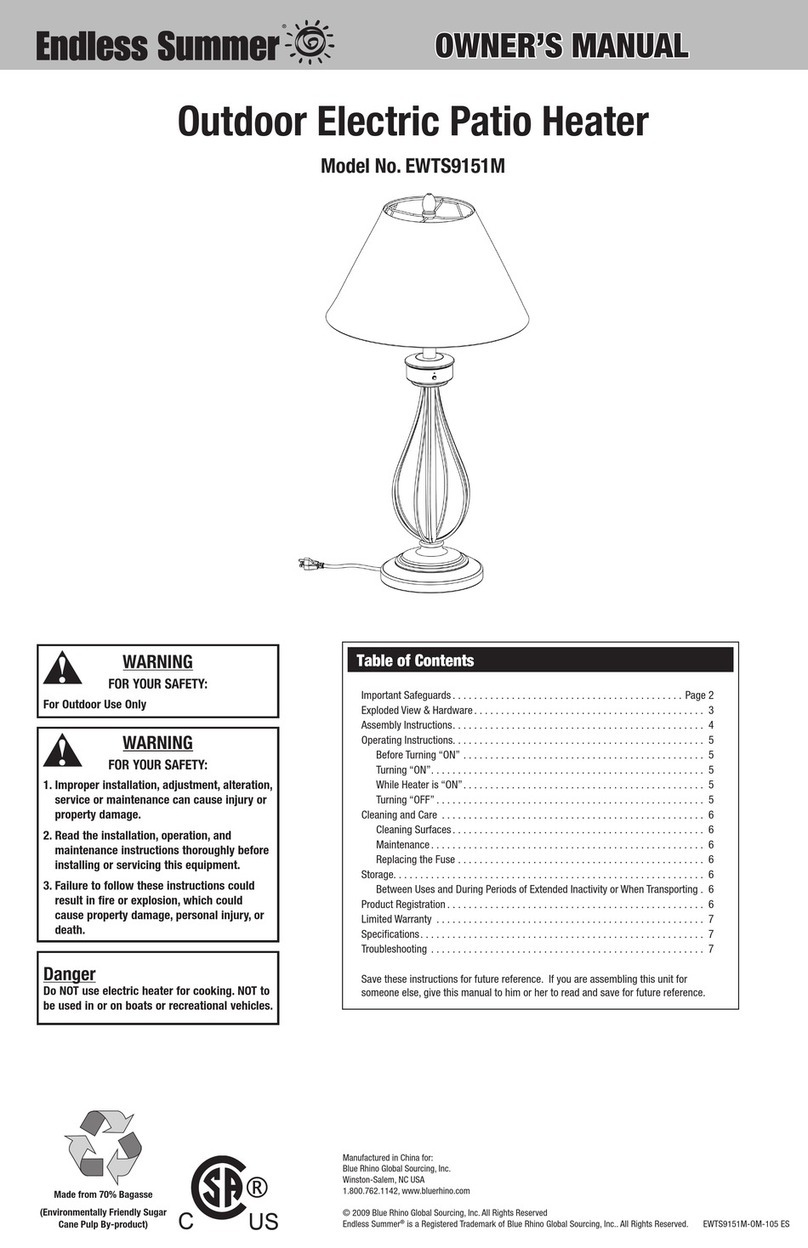
Endless Summer
Endless Summer EWTS9151M owner's manual

Backyard Pro
Backyard Pro PH08-SB quick start guide

CROWN VERITY
CROWN VERITY Patio Heater User installation and operation guide


